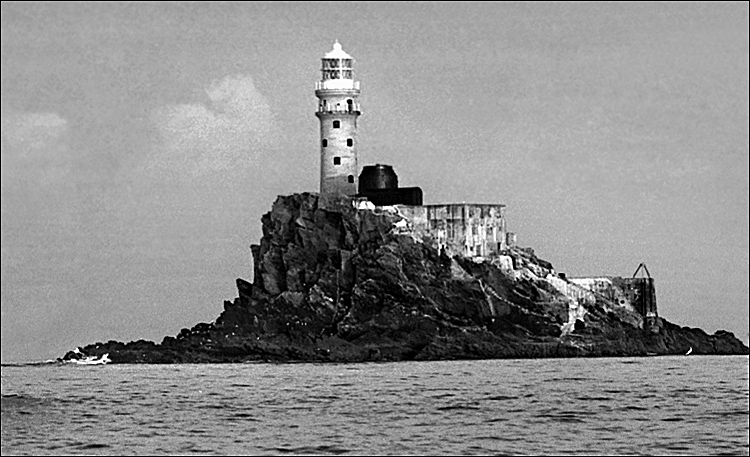Successful Raid on Fastnet Rock
For the IRA, one of the most effective means of coping with enemy transport was the road mine. For the manufacture of such mines explosives were the first necessity. In June 1921 the prospect of acquiring more gun-cotton came about when intelligence reports confirmed that for security reasons the British had stored large surplus quantities of explosive material in the Fastnet Rock lighthouse.
The lighthouse is ten miles from the mainland and about three miles south-west of the nearest land at Cape Clear Island. No serious resistance would be expected on the lighthouse itself, but many dangers had to be faced before there could be question of reaching the rock at all. There were forty-seven armed British Marines in the Coastguard Station at Schull and a British naval vessel kept a nightly patrol on the coast between Castletownsend Bay and Bantry Bay. Also, Fastnet Rock is notorious for its heavy swells, even in the finest weather. Finally, arrangements would have to be perfected for the safe disposal of the gun-cotton, once it was captured and successfully landed.
To make an unobserved landing on the Rock in the darkness of the night called for a man with local knowledge and good seamanship. John O'Regan had an unrivalled knowledge of the coast and was quite well acquainted with Fastnet but up to then had always landed there in daylight. Sean Lehane, Commandant of the Schull Battalion, was the man responsible for the projected raid. It was decided that the attempt would be made on the night of 28 June. John O'Regan was given the task of piloting the boat and of being the first to make the dangerous jump from the heaving deck to the slippery wave-washed rock.
Lehane borrowed a twenty-four foot Cape Clear fishing boat Maire Cait from its owner and the party prepered to set sail. As dusk deepened into darkness, the British destroyer that patrolled the coast from the Old Head of Kinsale to Bantry Bay appeared on the skyline and the intermittent sweep of her searchlights could be seen searching the sea and the coast. Veering off to keep out of the range of the probing beam, the Maire Cait, with the raiding party of twelve on board, waited in silence and watched the destroyer circle Fastnet Rock before making for Mizen Head on her way to Bantry Bay. The raiding party knew that they would have three hours at most in which to accomplish their mission, so they immediately sailed straight for their objective.
Shortly after midnight the boat approached Fastnet Rock. The sea had become choppy under a rising wind which caused the waters of the swell around the rock to rise and fall as much as eight feet. John O'Regan, with a rope tied around his waist, waited for the right moment to make the hazardous jump from the vessel to the slippery rock. At a given moment he jumped and the boat was quickly made fast. Fortunately, the two-ton steel door of the lighthouse was not locked, and led by O’Regan, the whole party raced up the spiral stairway. The lightkeeper put up no resistance and the wireless was dismantled. Seventeen boxes of gun-cotton and three boxes of detonators and primers weighting over half a ton were loaded on to the boat, using the lighthouse derrick. Within an hour it was out at sea again and heading for Long Island Sound. There, Mick O'Donovan and the men of the local Leamcon Company were waiting to begin unloading. Once the boxes were landed the whole consignment was safely dumped under a large heap of seaweed near the beach. It was so well camouflaged that it escaped detection in the raid that was carried out by the British military on the following day.
The first streaks of dawn were appearing in the east as the Maire Cait set out on her homeward journey to Cape Clear Island, carrying on board the four fishermen who had done so much to make a success of the Fastnet raid. On the mainland, Sean Lehane and the men of the Schull Battalion would soon disperse and return to their various occupations.





